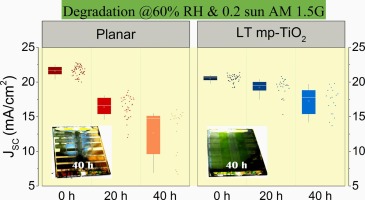当前位置:
X-MOL 学术
›
Sol. Energy
›
论文详情
Our official English website, www.x-mol.net, welcomes your
feedback! (Note: you will need to create a separate account there.)
Impact of the implementation of a mesoscopic TiO2 film from a low-temperature method on the performance and degradation of hybrid perovskite solar cells
Solar Energy ( IF 6.0 ) Pub Date : 2020-05-01 , DOI: 10.1016/j.solener.2020.03.041 Alejandra Castro-Chong , Weiming Qiu , Joao Bastos , Nadine Tchamba Yimga , Rodrigo García-Rodríguez , Jesús Idígoras , Juan A. Anta , Tom Aernouts , Gerko Oskam
Solar Energy ( IF 6.0 ) Pub Date : 2020-05-01 , DOI: 10.1016/j.solener.2020.03.041 Alejandra Castro-Chong , Weiming Qiu , Joao Bastos , Nadine Tchamba Yimga , Rodrigo García-Rodríguez , Jesús Idígoras , Juan A. Anta , Tom Aernouts , Gerko Oskam

|
Abstract High efficiencies of over 20% have been reported in the literature for both planar and mesoscopic hybrid perovskite solar cells, and the preferred configuration for scale-up and commercialization is still a matter of debate. The mesoscopic configuration generally requires a high-temperature processing step, which limits applications and makes the process less cost-effective. We have used low-temperature (LT) processing (≤120 °C) to fabricate high-efficiency planar and mesoscopic TiO2-based hybrid perovskite solar cells with comparable performance, highlighted by a champion LT mesoscopic solar cell with 16.2% efficiency. Photovoltaic efficiencies of 14–16% have been achieved for a mesoporous film thickness ranging from 120 to 480 nm by fine-tuning the precursor solution chemistry. The presence of the LT mesoporous layer improves the preservation of performance under conditions of relative humidity of 60%, especially under illumination. Impedance spectroscopy illustrates a similarity of the locus and kinetics of the recombination processes for both configurations. However, inductive loops usually related to ion migration are observed showing different characteristics between both configurations, pointing to the previously suggested correlation between ion migration and degradation. These results suggest that the beneficial role of a mesoporous TiO2 layer might be the stabilization of harmful defects at the perovskite/electron extraction layer interface, and indicate that interface engineering is critical to achieving improved long-term performance.
中文翻译:

低温法制备介观 TiO2 薄膜对混合钙钛矿太阳能电池性能和降解的影响
摘要 在文献中,平面和介观混合钙钛矿太阳能电池的效率均超过 20%,但放大和商业化的首选配置仍然存在争议。细观配置通常需要高温处理步骤,这限制了应用并降低了该过程的成本效益。我们使用低温 (LT) 处理 (≤120 °C) 来制造具有可比性能的高效平面和介观 TiO2 基混合钙钛矿太阳能电池,其中具有 16.2% 效率的冠军 LT 介观太阳能电池突出显示。通过微调前体溶液化学,对于 120 至 480 nm 的介孔膜厚度,已实现 14-16% 的光伏效率。LT 介孔层的存在改善了在 60% 相对湿度条件下的性能保存,尤其是在光照条件下。阻抗谱说明了两种配置的重组过程的轨迹和动力学的相似性。然而,观察到通常与离子迁移相关的感应回路在两种配置之间显示出不同的特征,表明之前建议的离子迁移与降解之间存在相关性。这些结果表明,介孔 TiO2 层的有益作用可能是稳定钙钛矿/电子提取层界面处的有害缺陷,并表明界面工程对于实现长期性能的改善至关重要。尤其是在光照下。阻抗谱说明了两种配置的重组过程的轨迹和动力学的相似性。然而,观察到通常与离子迁移相关的感应回路在两种配置之间显示出不同的特征,表明之前建议的离子迁移与降解之间存在相关性。这些结果表明,介孔 TiO2 层的有益作用可能是稳定钙钛矿/电子提取层界面处的有害缺陷,并表明界面工程对于实现改善的长期性能至关重要。尤其是在光照下。阻抗谱说明了两种配置的重组过程的轨迹和动力学的相似性。然而,观察到通常与离子迁移相关的感应回路在两种配置之间显示出不同的特征,表明之前建议的离子迁移与降解之间存在相关性。这些结果表明,介孔 TiO2 层的有益作用可能是稳定钙钛矿/电子提取层界面处的有害缺陷,并表明界面工程对于实现长期性能的改善至关重要。观察到通常与离子迁移相关的感应回路显示出两种配置之间的不同特征,表明之前建议的离子迁移与降解之间存在相关性。这些结果表明,介孔 TiO2 层的有益作用可能是稳定钙钛矿/电子提取层界面处的有害缺陷,并表明界面工程对于实现长期性能的改善至关重要。观察到通常与离子迁移相关的感应回路显示出两种配置之间的不同特征,表明之前建议的离子迁移与降解之间存在相关性。这些结果表明,介孔 TiO2 层的有益作用可能是稳定钙钛矿/电子提取层界面处的有害缺陷,并表明界面工程对于实现长期性能的改善至关重要。
更新日期:2020-05-01
中文翻译:

低温法制备介观 TiO2 薄膜对混合钙钛矿太阳能电池性能和降解的影响
摘要 在文献中,平面和介观混合钙钛矿太阳能电池的效率均超过 20%,但放大和商业化的首选配置仍然存在争议。细观配置通常需要高温处理步骤,这限制了应用并降低了该过程的成本效益。我们使用低温 (LT) 处理 (≤120 °C) 来制造具有可比性能的高效平面和介观 TiO2 基混合钙钛矿太阳能电池,其中具有 16.2% 效率的冠军 LT 介观太阳能电池突出显示。通过微调前体溶液化学,对于 120 至 480 nm 的介孔膜厚度,已实现 14-16% 的光伏效率。LT 介孔层的存在改善了在 60% 相对湿度条件下的性能保存,尤其是在光照条件下。阻抗谱说明了两种配置的重组过程的轨迹和动力学的相似性。然而,观察到通常与离子迁移相关的感应回路在两种配置之间显示出不同的特征,表明之前建议的离子迁移与降解之间存在相关性。这些结果表明,介孔 TiO2 层的有益作用可能是稳定钙钛矿/电子提取层界面处的有害缺陷,并表明界面工程对于实现长期性能的改善至关重要。尤其是在光照下。阻抗谱说明了两种配置的重组过程的轨迹和动力学的相似性。然而,观察到通常与离子迁移相关的感应回路在两种配置之间显示出不同的特征,表明之前建议的离子迁移与降解之间存在相关性。这些结果表明,介孔 TiO2 层的有益作用可能是稳定钙钛矿/电子提取层界面处的有害缺陷,并表明界面工程对于实现改善的长期性能至关重要。尤其是在光照下。阻抗谱说明了两种配置的重组过程的轨迹和动力学的相似性。然而,观察到通常与离子迁移相关的感应回路在两种配置之间显示出不同的特征,表明之前建议的离子迁移与降解之间存在相关性。这些结果表明,介孔 TiO2 层的有益作用可能是稳定钙钛矿/电子提取层界面处的有害缺陷,并表明界面工程对于实现长期性能的改善至关重要。观察到通常与离子迁移相关的感应回路显示出两种配置之间的不同特征,表明之前建议的离子迁移与降解之间存在相关性。这些结果表明,介孔 TiO2 层的有益作用可能是稳定钙钛矿/电子提取层界面处的有害缺陷,并表明界面工程对于实现长期性能的改善至关重要。观察到通常与离子迁移相关的感应回路显示出两种配置之间的不同特征,表明之前建议的离子迁移与降解之间存在相关性。这些结果表明,介孔 TiO2 层的有益作用可能是稳定钙钛矿/电子提取层界面处的有害缺陷,并表明界面工程对于实现长期性能的改善至关重要。











































 京公网安备 11010802027423号
京公网安备 11010802027423号